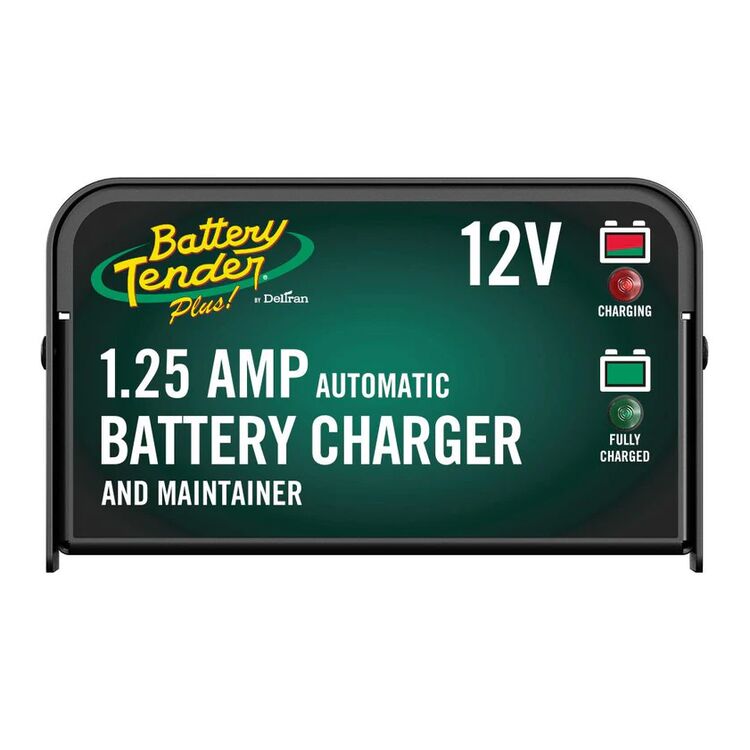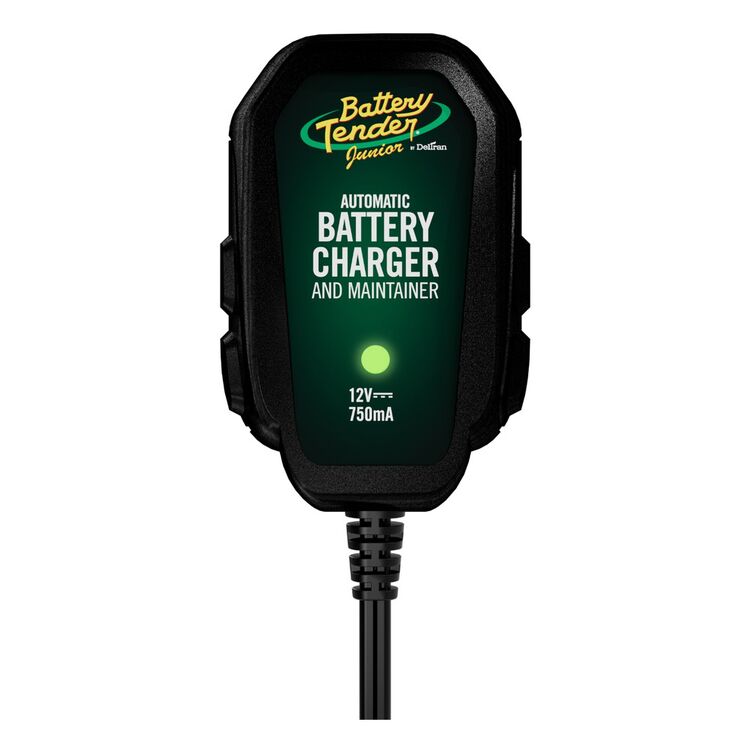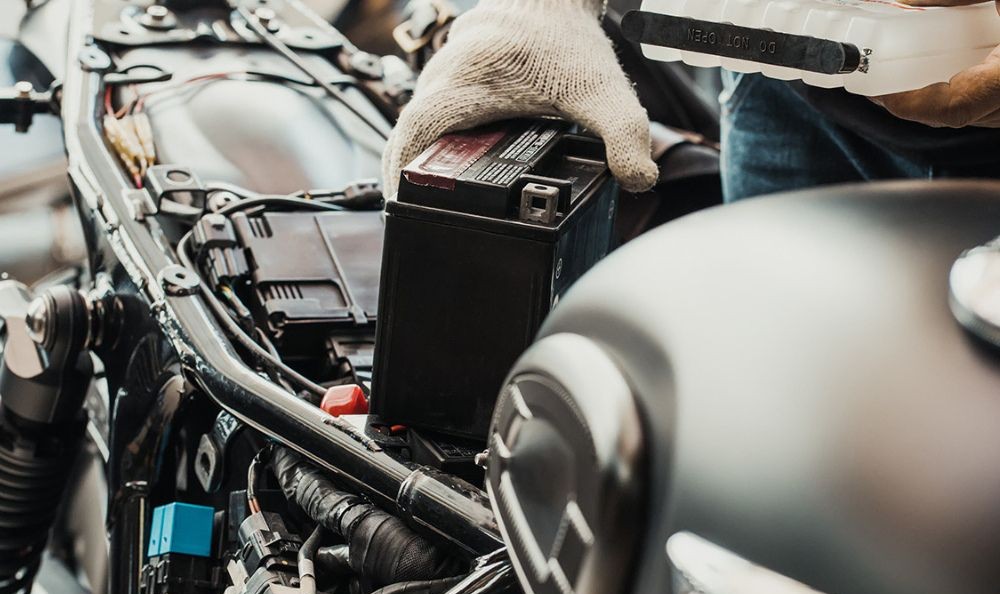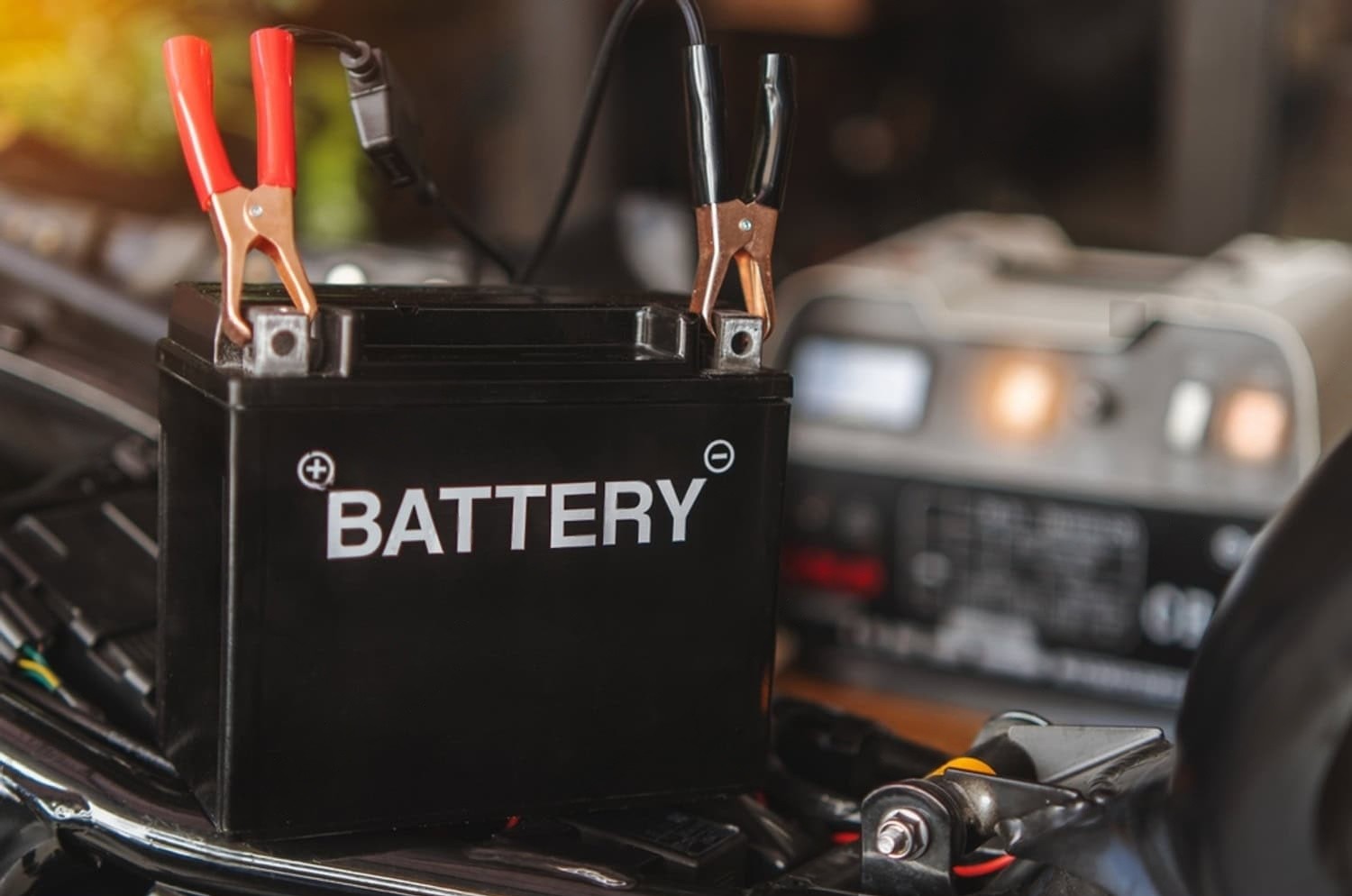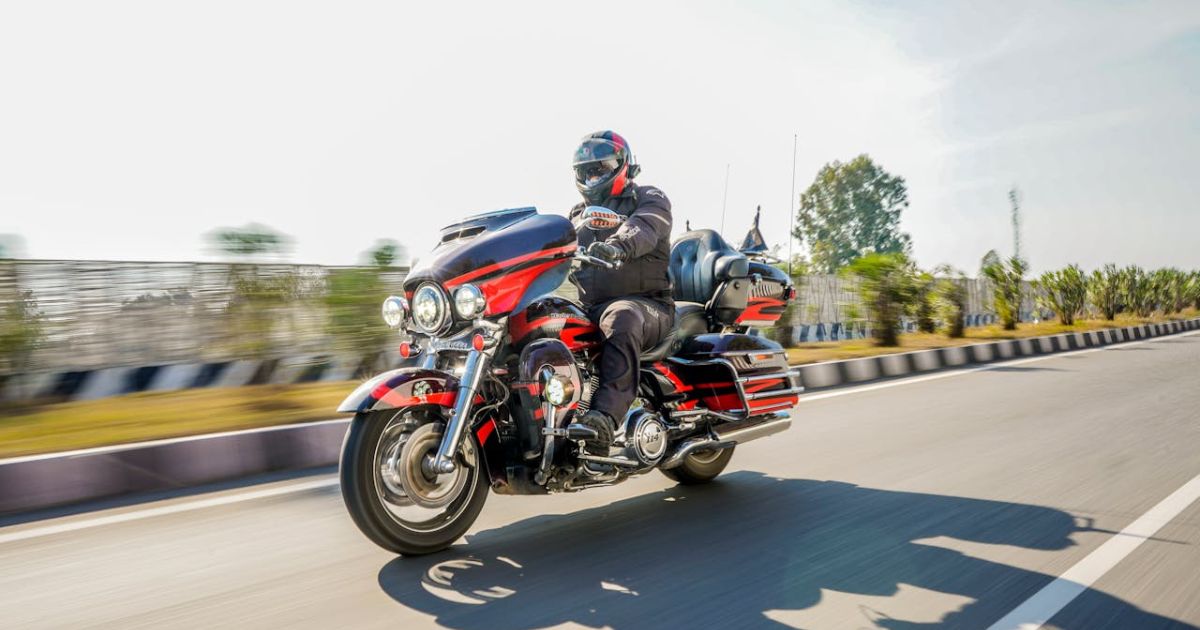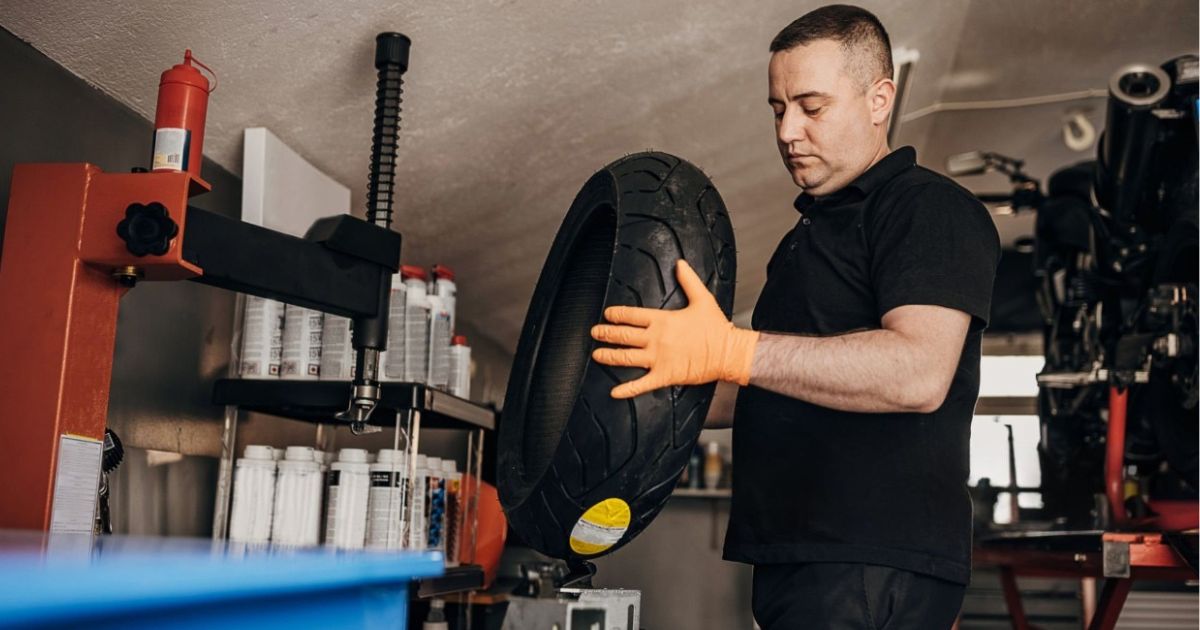
Top Motorcycle Battery Chargers for Lithium, AGM & More
left for contents
Your battery doesn’t care how far you ride, only how often. And if you’re not starting the engine every few days, you’re already on borrowed volts.
That’s the situation most riders face, especially during the off-season or after a week of rain. You gear up for a ride, thumb the starter, and… nothing. Just the cold click of neglect. And yeah, we’ve all been there, wrestling the seat off, yanking a charger from the back of the garage, wondering if that old trickle box even still works.

Source
In this guide, I’ll break down the best motorcycle battery chargers and tenders for real-world use, not just what looks good in a spec sheet. Whether you’re storing a bike for winter, reviving a neglected AGM, or just want peace of mind in your saddlebag, there’s a charger here that’ll do the job right.
And if your battery’s already toast? Start with our full guide to the best motorcycle batteries. Pick the right power source first, then keep it alive with the right charger.
Quick Picks: Best Motorcycle Battery Chargers
Want the fast answer? These top three picks cover the most common rider needs without overcomplicating things. Whether you want one charger to handle every battery type, something tailored for old-school lead-acid, or just a reliable budget option, these choices deliver. Simple, effective, and road-tested—no guesswork required.
If you want one charger that does it all (lithium, AGM, lead-acid, dead battery revival, fast charging) the GENIUS10 is it. It’s compact, smart, temperature-adjusting, and rugged enough for garage or road use. This is the one I’d pick if I could only own one. | Designed specifically for 12V flooded lead-acid systems, this charger has just the right amount of juice and logic to keep old-school batteries healthy without risk of overcooking. Set it, forget it, and your battery will stay topped off without fail. | This little unit has been quietly keeping batteries alive for years, and for under 40 bucks, it’s still one of the smartest buys out there. The Junior delivers a 4-step automatic charging cycle that handles flooded, AGM, and gel lead-acid batteries with no risk of overcharging. |
|
|
|
|
|
|
If you want one charger that does it all (lithium, AGM, lead-acid, dead battery revival, fast charging) the GENIUS10 is it. It’s compact, smart, temperature-adjusting, and rugged enough for garage or road use. This is the one I’d pick if I could only own one.
- Revives deeply discharged batteries
- Automatic temperature-compensated charging
- Safe to leave connected indefinitely
- Compact yet charges faster than lower-amp models
- Durable clamps and weather-resistant design
- Cables may stiffen in extreme cold
Designed specifically for 12V flooded lead-acid systems, this charger has just the right amount of juice and logic to keep old-school batteries healthy without risk of overcooking. Set it, forget it, and your battery will stay topped off without fail.
- Fully charges, then auto-maintains safely
- Protects battery from overcharging
- Spark-proof and reverse-polarity safe
- Compact design fits in small spaces
- Backed by a 10-year manufacturer warranty
- Slower charging for large batteries
- May require adapter for some terminals
This little unit has been quietly keeping batteries alive for years, and for under 40 bucks, it’s still one of the smartest buys out there. The Junior delivers a 4-step automatic charging cycle that handles flooded, AGM, and gel lead-acid batteries with no risk of overcharging.
- Fully charges batteries then maintains them safely
- Smart 4‑stage charge protects battery lifespan
- Spark-proof and reverse-polarity safe
- Compact, lightweight—great for tight garage space
- Extends battery life and readiness during storage
- Slow charge on large/low batteries at only
- May need adapter for hard-to-reach battery terminals
Battery Chargers: Myths That Need to Die
Somewhere between the owner’s manual and the third beer in the garage, a lot of half-truths about battery chargers have taken root. Let’s cut through the static. Here’s what actually matters, and what doesn’t.
“You don’t need a charger if you ride regularly.”
That depends on what “regularly” means. If your idea of frequent riding is once every two weeks, your battery disagrees. Short rides and cold starts take more than they give. Even weekend warriors can benefit from a maintainer that keeps things topped off.
Cold starts and stale fuel go hand in hand: If your bike’s been sitting, pair your battery charger with a can of the best carb cleaner and give the fuel system a fresh shot too.
“All chargers work on all batteries.”
Not true. Lithium, AGM, and lead-acid batteries each have different charging profiles. Using the wrong charger can shorten battery life—or in some cases, not charge it at all. Always match the charger to the battery type. Most good ones handle multiple chemistries, but don’t assume.
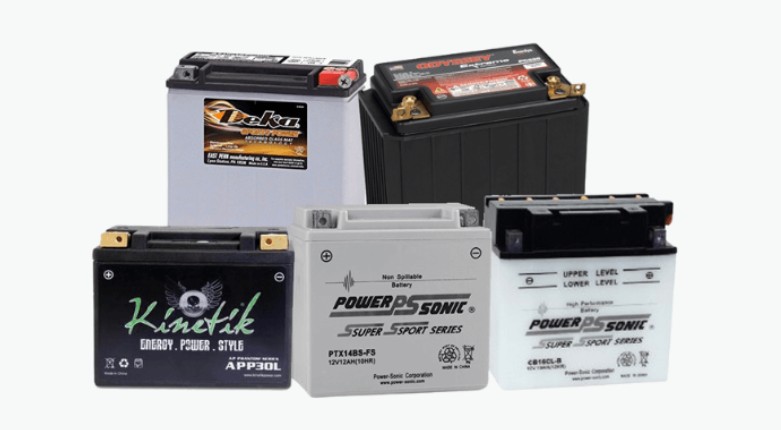
Source
“More amps means better charging.”
Only if you’re in a hurry, and even then it’s a maybe. Flooding a small motorcycle battery with high amps can heat things up fast, and not in a good way. For everyday maintenance, 0.75 to 2 amps is usually the sweet spot.
“You can leave it plugged in forever.”
With a smart charger, yes. With an old trickle charger? Not unless you like the smell of boiling electrolyte. Smart chargers monitor voltage and pulse as needed. Old-school trickle chargers just… trickle. Forever.
Let’s ride with facts, not folklore.
Chargers That Actually Deliver: Picks That Earn Their Spot
Let’s skip the overhyped junk and get straight to what works. Below are the chargers I trust in my own garage. Tested, proven, and sorted from the most versatile all-rounders to the ones that serve a specific niche. Whether you’re maintaining a battery through winter or reviving one that’s on life support, there’s a charger here that’ll do the job without frying your bike or wasting your time.
NOCO GENIUS10 10A Smart Battery Charger
Why it works:
This isn’t just a charger. It’s a battery lifesaver with a brain. The NOCO GENIUS10 handles everything from basic top-offs to deep recoveries, and it works across 6V and 12V batteries, including flooded lead-acid, AGM, gel, and even lithium-ion (LiFePO4). It’s built with an integrated thermal sensor that automatically adjusts voltage and current based on ambient temperature. That means no overcharging on hot days and no limp performance in the cold. It can wake up batteries drained down to just 1 volt, and if your battery is completely dead, “Force Mode” gives you manual control to push charge into it without waiting for auto-detection.
Another win? The rugged, compact housing makes it easy to toss in a bag or mount on a garage wall. And it’s not just smart about voltage. It runs diagnostics, detects sulfation, and even includes battery desulfation mode to recover lost performance. All of this packed into a charger smaller than most maintenance units.

Source
What to keep in mind:
The 10A output sounds big, and it is. But thanks to its smart charging logic, it won’t overload small motorcycle batteries unless you manually override it. Still, if you’re just looking to maintain a small 12V battery over the winter, this might be overkill in both size and price. Think of it as a pro-grade tool that works great for bikes, but could also pull double duty for cars, ATVs, and lawn equipment. Just make sure you respect its muscle.
If you want one charger that does it all (lithium, AGM, lead-acid, dead battery revival, fast charging) the GENIUS10 is it. It’s compact, smart, temperature-adjusting, and rugged enough for garage or road use. This is the one I’d pick if I could only own one.
- Revives deeply discharged batteries
- Automatic temperature-compensated charging
- Safe to leave connected indefinitely
- Compact yet charges faster than lower-amp models
- Durable clamps and weather-resistant design
- Cables may stiffen in extreme cold
Battery Tender Plus 1.25A 12V Charger
Why it works:
This one’s a classic, and for good reason. The Battery Tender Plus has been keeping 12V lead-acid batteries alive for decades, and it still hits the sweet spot for most motorcycles. No bells, no gimmicks—just a well-designed 1.25-amp smart charger that delivers steady power and automatic float when the job’s done. That float mode is what saves you from cooking your battery over time, especially if you’re plugging in for winter or storing the bike for weeks on end.
It’s compatible with flooded, AGM, and gel batteries, and the included quick-disconnect cable makes it super easy to hook up, even on bikes with awkward battery access. It’s also backed by a strong track record and a 10-year warranty, which speaks volumes about how many riders trust it season after season.
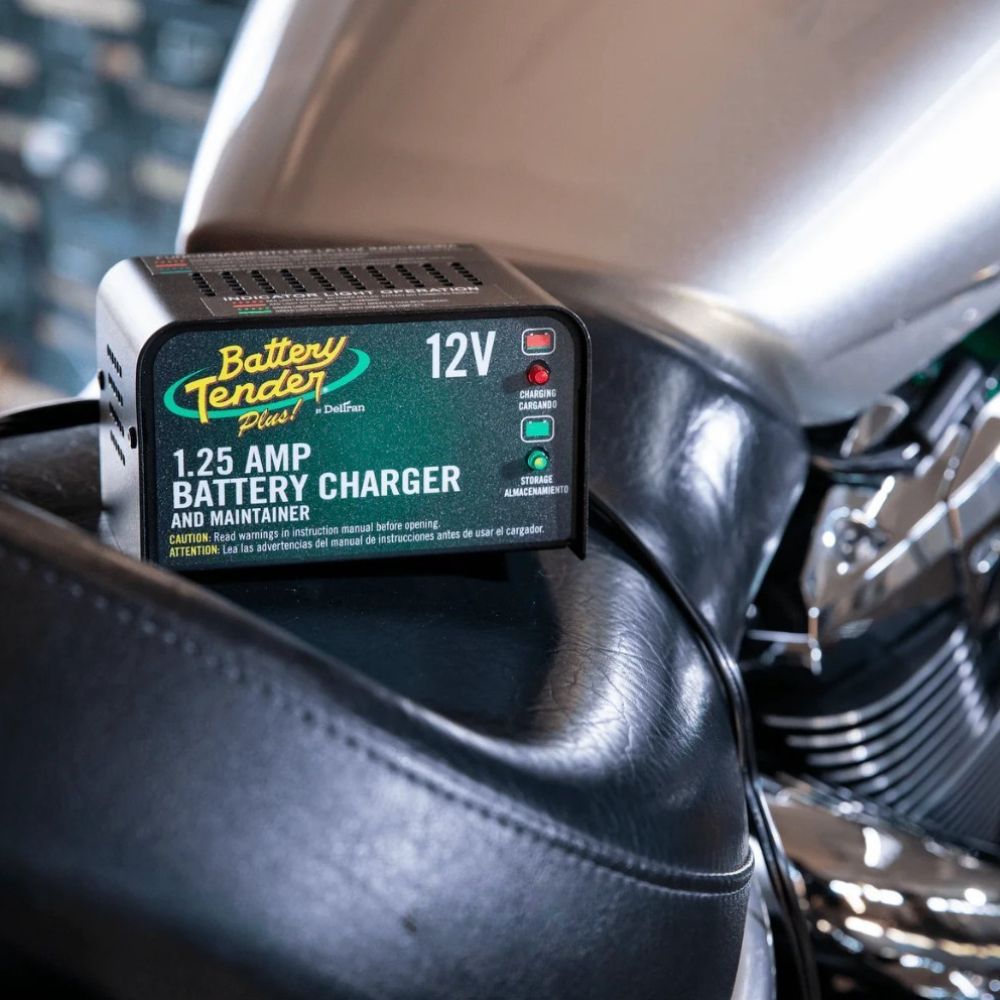
Source
What to keep in mind:
It’s not fast. If your battery is nearly dead, the 1.25A output means you’re in for a slow recovery. And there’s no lithium support here—this charger is built with conventional batteries in mind. But if you ride with standard lead-acid or AGM and want something you can set and forget without worrying about frying your bike’s electrical system, this is still one of the safest bets out there. Old school, but smart where it counts.
Designed specifically for 12V flooded lead-acid systems, this charger has just the right amount of juice and logic to keep old-school batteries healthy without risk of overcooking. Set it, forget it, and your battery will stay topped off without fail.
- Fully charges, then auto-maintains safely
- Protects battery from overcharging
- Spark-proof and reverse-polarity safe
- Compact design fits in small spaces
- Backed by a 10-year manufacturer warranty
- Slower charging for large batteries
- May require adapter for some terminals
Battery Tender Junior 12V, 750mA Charger and Maintainer
Why it works:
If you just need a battery to stay alive through winter, the Battery Tender Junior gets it done without fuss. It’s a 750mA smart charger made for maintaining lead-acid, AGM, and gel-cell batteries, and it’s been doing that job reliably for years. Plug it in, walk away, and your battery stays fresh without ever getting overcharged. The microprocessor-controlled charging cycle keeps things simple (bulk charge, absorption, float) and that’s all most riders really need.
It comes with ring terminals and alligator clips, plus a built-in quick disconnect that makes it easy to set up on a bike that doesn’t have easy battery access. No menus, no modes, just a compact little unit that quietly keeps your battery from dying while the bike’s parked.
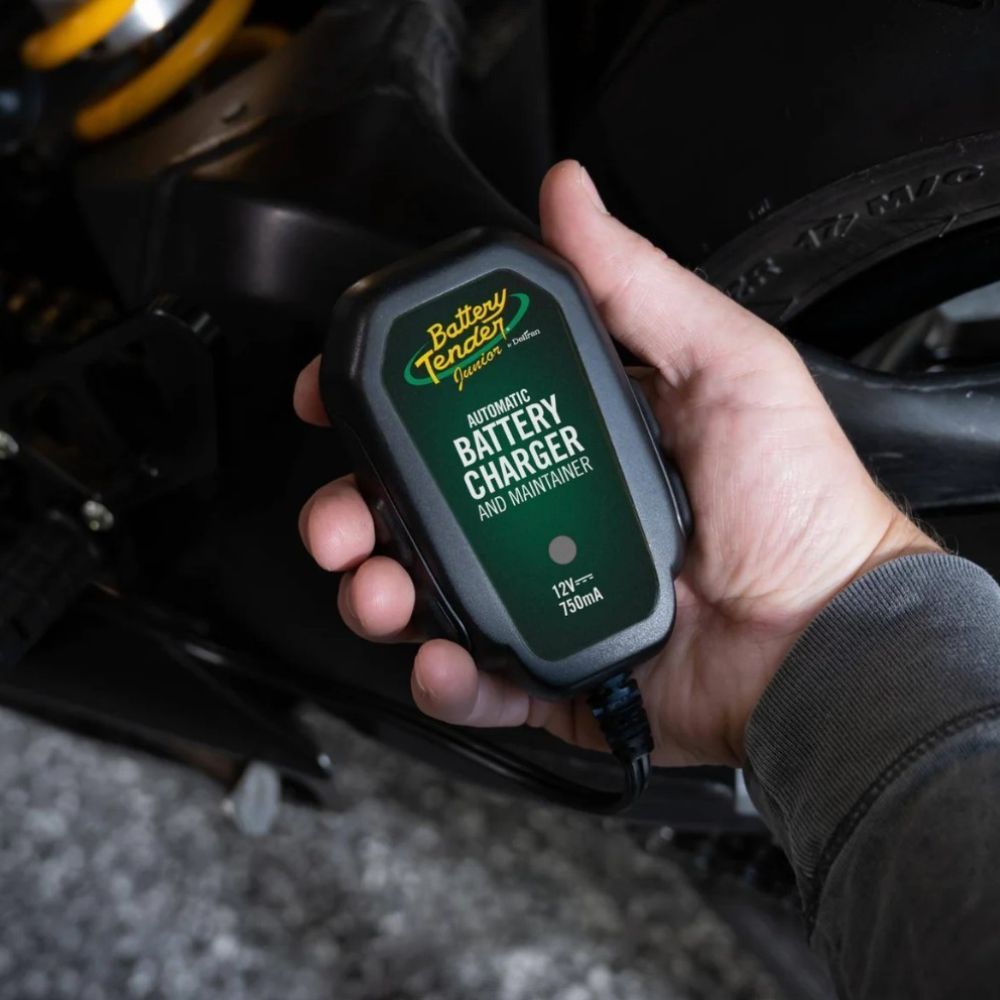
Source
What to keep in mind:
At 750 milliamps, it’s a trickle maintainer, not a charger in the “bring it back from the dead” sense. If your battery is already drained hard, this one’s going to take a long time, or it might not recover it at all. It also doesn’t work with lithium batteries, so skip it if you’ve upgraded from stock.
But for old-school 12V batteries, especially in bikes that get stored for months at a time, the Junior is a proven, low-cost solution. It’s the charger I’d hand to any new rider who wants peace of mind without spending a fortune. Just plug it in and let it keep your battery breathing.
This little unit has been quietly keeping batteries alive for years, and for under 40 bucks, it’s still one of the smartest buys out there. The Junior delivers a 4-step automatic charging cycle that handles flooded, AGM, and gel lead-acid batteries with no risk of overcharging.
- Fully charges batteries then maintains them safely
- Smart 4‑stage charge protects battery lifespan
- Spark-proof and reverse-polarity safe
- Compact, lightweight—great for tight garage space
- Extends battery life and readiness during storage
- Slow charge on large/low batteries at only
- May need adapter for hard-to-reach battery terminals
CTEK MXS 5.0 12V Battery Charger
Why it works:
Sometimes it’s not about raw amperage, it’s about how cleanly and intelligently the job gets done. The CTEK MXS 5.0 is built for riders who want their battery maintained with surgical precision, not brute force. It walks through a full 8-stage charging cycle, including desulfation, analysis, bulk charge, and reconditioning—automatically. No buttons, no guesswork. Just hook it up and it knows what to do, whether you’re dealing with a healthy AGM or a neglected wet cell that’s been sitting too long.
This charger is especially dialed for AGM batteries, which can be picky about voltage and recovery. The CTEK handles them without breaking a sweat and includes temperature compensation to keep performance consistent whether you’re wrenching in the garage or a cold shed. Add in its IP65 weather resistance, compact size, and no-spark connection system, and you’ve got a charger you can trust to babysit your battery all winter without lifting a finger.

Source
What to keep in mind:
It doesn’t work with lithium batteries, so if you’ve upgraded to LiFePO4, skip this one. And while the 4.3-amp output is ideal for motorcycles, it’s not built to boost bigger vehicle batteries in a hurry. What you get instead is smooth, deliberate charging that actually improves long-term battery life, perfect for riders who want to protect their investment, not just wake it up.
Advanced 8‑step charger and maintainer for 12 V lead‑acid batteries (WET, AGM, GEL). Revives weak batteries, has temperature compensation, and switches to safe float mode automatically.
- Fully reconditions deeply discharged batteries
- Automatic temperature‑compensated charging
- Connect‑and‑forget maintenance mode
- Robust build quality and splash-resistant design
- Includes eyelet and clamp connectors
- Mode selection requires manual switching
- Standard cables are relatively short
NOCO GENIUS1 1A Smart Battery Charger
Why it works:
Small, sharp, and smarter than it looks, the NOCO GENIUS1 is a solid pick for anyone who just wants to keep their battery topped off without overthinking it. It supports 6V and 12V systems, works with lead-acid, AGM, and lithium (LiFePO4) batteries, and fits in the palm of your hand. For a 1-amp unit, it’s packed with tech: automatic voltage detection, thermal compensation, battery diagnostics, and even a Force Mode to manually override its safety lockouts when you’re trying to wake up a battery the smart system won’t recognize.
This is a charger that doesn’t just work quietly in the background—it works smart. It knows when to push and when to ease off, which makes it ideal for long-term battery care or bikes that sit more than they run. For the size and price, the GENIUS1 is tough to beat.
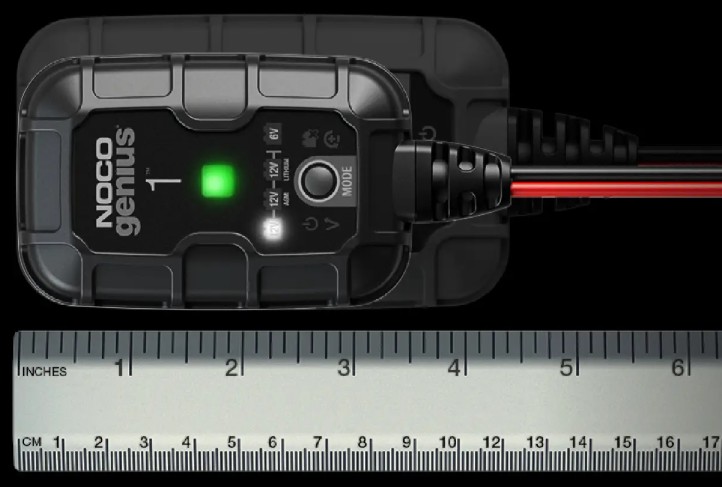
Source
What to keep in mind:
Don’t expect it to bring a completely dead or deeply drained battery back to life quickly. At 1 amp, it’s strictly a maintainer—not a recovery tool. It’ll get there, but it’ll take time. Also, the all-in-one cable setup doesn’t include a detachable SAE quick connect, so installing a pigtail is a bit less convenient than some competitors.
Still, for a travel-ready, lithium-safe charger you can trust with any 12V bike battery, the GENIUS1 punches well above its weight class. It’s the kind of tool you forget about until the day you’re glad you had it.
Compact 1 A smart charger and maintainer for 6 V/12 V lead-acid and lithium batteries. It revives weak batteries, prevents sulfation, and auto-switches to safe float mode.
- Effectively revives deeply discharged batteries
- Safe to leave connected for months
- Automatic temperature-compensated charging
- Compact and portable with long cable
- Supports lead-acid and lithium batteries
- 1A output is slow for large or dead car batteries
- Force mode may not activate at very low voltage
ECO-WORTHY 12V 5A Lithium Battery Charger
Why it works:
The ECO-WORTHY 12V 5A charger is built to handle lithium (LiFePO₄) and standard lead-acid batteries, including flooded types. It delivers a steady 5 amps for fast, safe charging and features built-in protection against over-voltage, over-current, and short circuits. Straightforward and efficient, it gets the job done without unnecessary extras.
The LCD display is basic but functional, giving you clear readouts on charging progress and battery condition. You also get both clamp and ring terminal connectors in the box, so setup is easy whether you’re charging from a bench or hardwiring it to a parked bike.
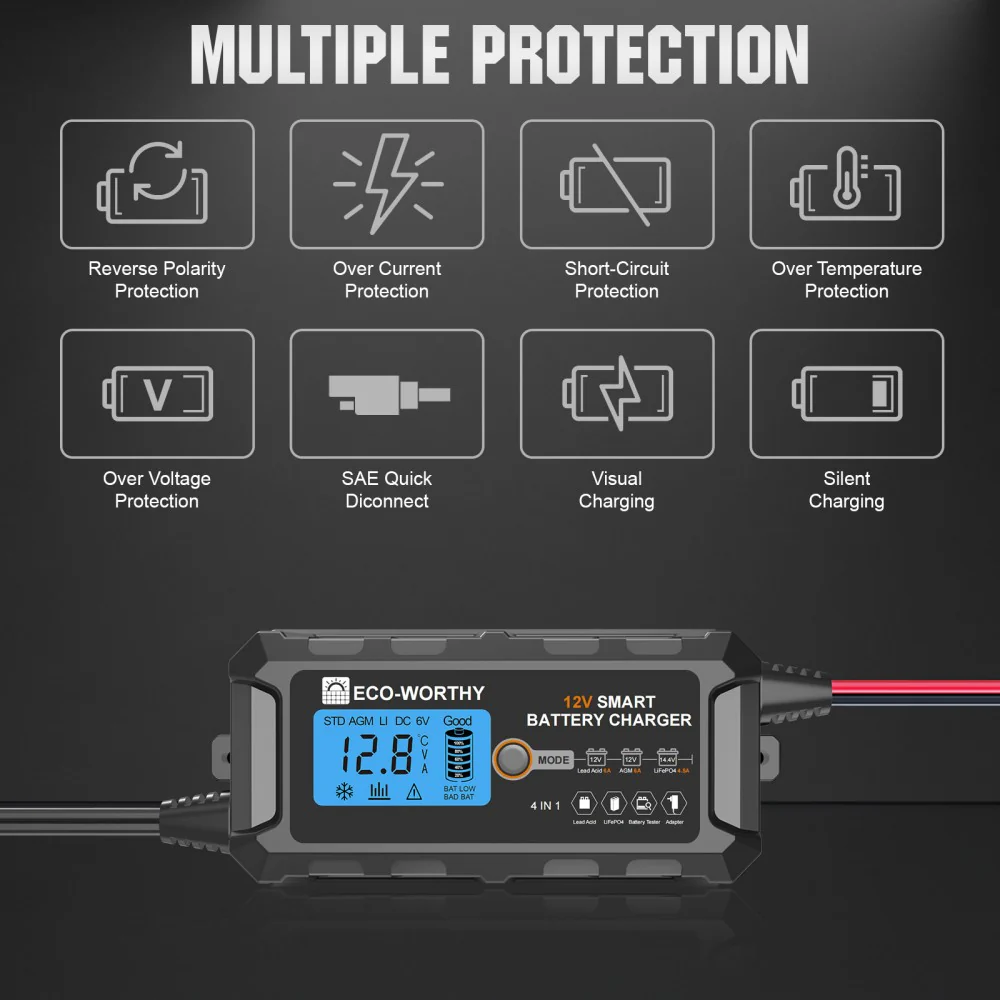
Source
What to keep in mind:
This charger handles the essentials well but skips the fancier extras. You won’t find recovery modes, desulfation, or deep diagnostics here. It’s also more of a charger than a maintainer (there’s no float mode) so it’s best for active upkeep rather than long-term winter storage.
Still, for the price, it covers a lot of ground and gets the job done without drama. If you need a straightforward 5A charger that plays nice with both lithium and lead-acid batteries, this is one of the most budget-friendly ways to do it right.
Versatile 5 A smart charger with LCD for 12 V lead-acid and LiFePO₄ batteries. Automatically adapts to battery health and maintains long-term readiness.
- Charges and maintains a wide range of battery types
- Clear LCD shows real-time charge status
- Compact, sturdy design fits in tool bags
- Intelligent mode adjusts for battery condition
- Capable of 24/7 plug-and-play operation
- Can get quite warm during charging highs
- Not ideal for batteries over ~100 Ah (slow charge)
NEXPEAK NC301 20A Smart Charger
Why it works:
Power is what defines the NEXPEAK NC301. It delivers 20 amps straight to a weak battery and gives it a serious shot at recovery. This charger is built more like a workshop tool than a passive maintainer, and it’s especially useful for riders juggling multiple vehicles. It works with 12V and 24V systems, handles flooded, AGM, and LiFePO4 batteries, and includes a surprisingly thoughtful set of features: temperature compensation, reverse polarity protection, and even an auto-repair function to restore sulfated or low-capacity batteries.
For those with touring bikes, side-by-sides, or just a mix of gear in the garage, the NC301 offers serious bang for the buck. It also comes with a long cable, fan cooling, and a clean digital display, which gives it a more professional feel than most chargers in its price range.
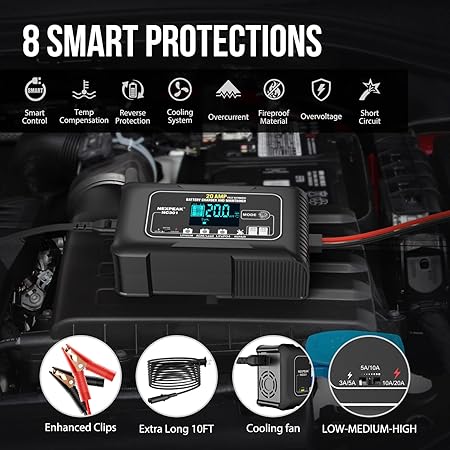
What to keep in mind:
All that amperage is more than most motorcycles need. If you’re charging a small 12V bike battery, you’ll want to keep an eye on it or manually reduce the current. It’s also not designed for long-term maintenance, so skip this one if you’re just trying to keep a stored battery alive.
But for fast charges, dead battery recoveries, or mixed-vehicle setups, the NC301 delivers serious power with better control than you’d expect at this price. It’s the muscle car of chargers. Plenty of grunt, clean execution, and no hesitation when you hit the switch.
Versatile smart charger (20 A for 12 V, 10 A for 24 V) with LCD and temperature compensation. Quickly charges and maintains lead-acid, AGM, GEL, and LiFePO₄ batteries for long-term use.
- Fast charging with clear LCD readout
- Adapts to battery health and temperature
- Offers pulse desulfation to restore performance
- Multi-voltage support (12 V & 24 V, multiple chemistries)
- 24/7 plug‑and‑play maintenance mode
- Can run hot under heavy load
- Cables may be shorter than ideal
Motorcycle Battery Chargers Comparison
| NOCO GENIUS10 | CTEK MXS 5.0 | Battery Tender Plus 1.25A | NOCO GENIUS1 | Battery Tender Junior 750mA | ECO-WORTHY 12V 5A | NEXPEAK NC301 20A | |
| Battery Types | 6V/12V Lead-Acid, AGM, Gel, Lithium | 12V Lead-Acid, AGM, Gel | 12V Lead-Acid, AGM, Gel | 6V/12V Lead-Acid, AGM, Gel, Lithium | 12V Lead-Acid, AGM, Gel | 12V Lithium (LiFePO4), Lead-Acid, AGM | 12V/24V Lead-Acid, AGM, Gel, Lithium |
| Amperage | 10A | 4.3A | 1.25A | 1A | 0.75A | 5A | 20A |
| Smart Features | Thermal compensation, diagnostics, Force Mode | 8-stage charging, temp compensation, reconditioning | 4-stage charging, float mode | Auto voltage detection, thermal comp, Force Mode | 4-stage charging, float mode | Auto shut-off, low-voltage detection | Temp comp, auto-repair, reverse polarity protection |
| Lithium Support | Yes | No | No | Yes | No | Yes (LiFePO4 only) | Yes |
| Best Use Case | All-purpose, fast charging, dead battery recovery | AGM batteries, precision maintenance | Conventional battery maintenance | Basic smart maintainer for all types | Budget maintainer for lead-acid | Safe lithium charging | High-power, multi-vehicle fast charging |
| Price Range | $$$ | $$$ | $$ | $$ | $ | $$ | $$$$ |
| Get one | Check price | Check price | Check price | Check price | Check price | Check price | Check price |
How to Charge Your Motorcycle Battery the Right Way
It’s not rocket science but doing it wrong can still fry your battery. Whether you’re storing the bike for winter or reviving it after a cold snap, charging your battery correctly makes all the difference. Here’s a step-by-step guide that keeps things safe, simple, and rider-proof.
Step 1: Identify Your Battery Type. Check your battery label or manual. Most bikes use:
- Flooded Lead-Acid (you’ll see removable caps or vent tubes)
- AGM (sealed, labeled as AGM or VRLA)
- Lithium (LiFePO4) (lightweight, often used in performance or ADV setups)
Make sure your charger is compatible. Some chargers do all three. Others don’t.
And while you’re under the seat checking your battery, it’s the perfect time to knock out a quick detail job too. See our picks for the best motorcycle cleaners to keep your bike as fresh on the outside as it is under the tank.
Step 2: Disconnect the Battery (Optional but Smart).
- You can charge the battery while it’s on the bike, but disconnecting the negative terminal prevents accidental shorts or interference with the bike’s electronics. If you’re using a quick-connect lead, you can skip this.
Step 3: Connect the Charger Properly
- Red clip to the positive terminal (+)
- Black clip to the negative terminal (–)
If you’re using a ring terminal harness, just plug it in.
Step 4: Power Up the Charger
- Plug the charger into the wall after it’s connected to the battery. Most smart chargers will auto-detect voltage and begin cycling through stages like bulk, absorption, and float.
- For lithium batteries, make sure your charger is set to the correct mode if it has one.
Step 5: Let It Run
- Leave it alone and let the charger do its thing. Smart chargers will shut off or enter maintenance mode when the battery is full. Old-school chargers need to be manually disconnected once the job is done.
Step 6: Check the Status
- Most modern chargers have LED indicators or digital readouts showing progress. Green light? You’re good. If you see error codes or blinking red, consult the charger manual before proceeding.
Step 7: Disconnect in Reverse
- Unplug the charger from the wall
- Remove the negative terminal first, then the positive
If you disconnected the battery from the bike, reconnect the terminals and you’re ready to ride.
Charging your battery the right way takes ten minutes to set up and saves you from hours of headaches down the line. Treat it like part of your regular maintenance and you’ll get way more life out of every battery you buy.
How to Choose the Right Motorcycle Battery Charger
Don’t just grab the first charger off the shelf, pick one that actually fits how, what, and where you ride. A good charger keeps your battery healthy without babysitting. The right one can extend battery life, prevent mid-season failures, and save you cash in the long run. But not all chargers are built for the same job, and throwing the wrong one at your battery can do more harm than good.
This quick guide walks you through the key things to look for, so you can make the right call the first time.
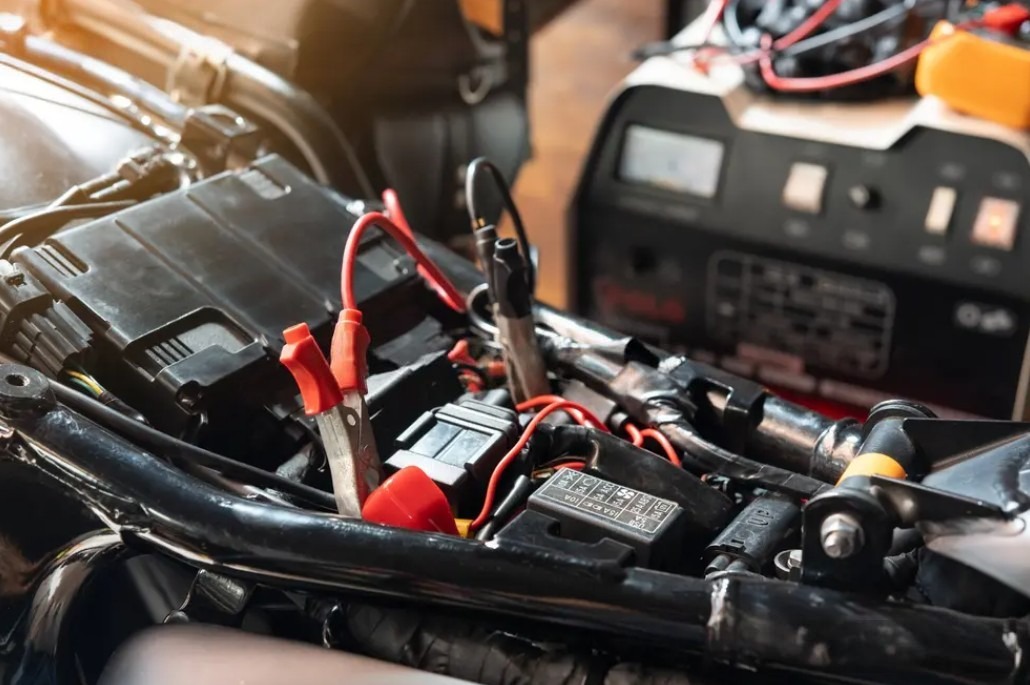
Source
Know Your Battery Type. Not all chargers work with all battery chemistries. The three most common are:
- Flooded lead-acid (conventional): Basic chargers like the Battery Tender Junior or Plus will do the job just fine.
- AGM (Absorbed Glass Mat): These batteries prefer controlled charging with proper float and absorption modes. Look for something like the CTEK MXS 5.0 that offers AGM support.
- Lithium (LiFePO4): Needs specific voltage regulation and cutoff logic. Only use chargers clearly marked as lithium-compatible, like the NOCO GENIUS10 or ECO-WORTHY 5A.
Consider Charging Speed (Amperage). Higher amps mean faster charging, but more isn’t always better for motorcycles.
- 0.75A–1.25A: Great for battery maintenance and storage.
- 2A–5A: Ideal for routine use without stressing the battery.
- 10A and up: Useful for quick recovery or multi-vehicle garages, but overkill for basic maintenance unless the charger adjusts automatically.
Smart chargers are worth it, period. Look for:
- Automatic shutoff and float mode to prevent overcharging
- Temperature compensation for consistent output in hot or cold garages
- Battery diagnostics to catch problems early
- Force Mode or recovery functions if you ever run batteries down to near-zero
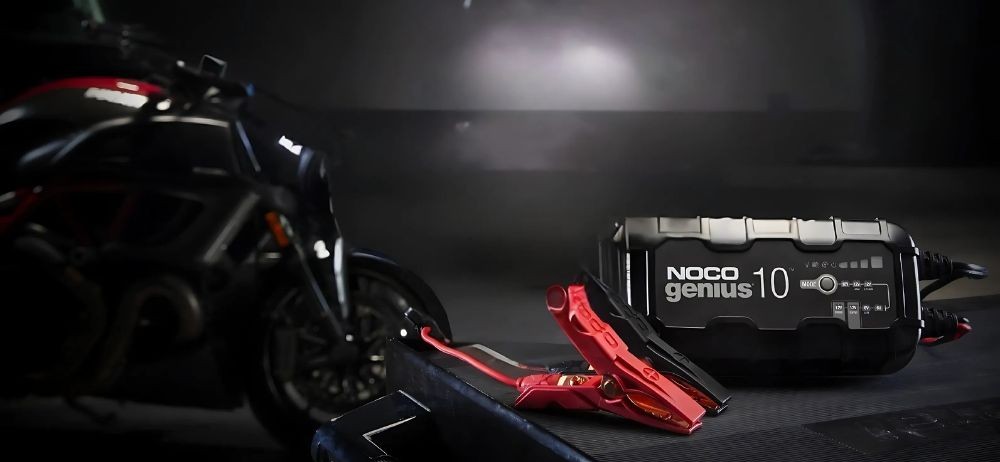
Source
Match the Charger to Your Use Case
- For winter storage: Go small and smart. A 0.75A–1A maintainer is plenty. Keeping your battery healthy through winter is only half the battle. Protect the whole bike with one of the best motorcycle shelters we’ve tested for year-round coverage.
- For multiple bikes or seasonal machines: A mid-range 4A–10A charger covers more ground without overcomplicating things.
- For emergency recovery or dead batteries: Look for a charger with manual override or recovery mode (like NOCO’s GENIUS line or the NEXPEAK NC301).
Don’t Forget the Basics. Check cord length, connector options (ring terminals vs clamps), and whether the charger is weather-resistant. These little things make a big difference when you’re reaching into a tight battery tray or charging outdoors.
Pick the right charger once, and it’ll outlast multiple batteries. Pick the wrong one, and you’ll be shopping for both sooner than you’d like.
Motorcycle Battery Chargers FAQ
Got questions? Good. Let’s clear up the confusion. Choosing a charger isn’t just about volts and amps, it’s about knowing what keeps your bike ready to fire up every time. Here are straight answers to the questions riders ask most.
What’s the difference between a charger and a maintainer?
A charger fills the battery up. A maintainer keeps it topped off once it’s full. Smart chargers usually do both, switching to float mode automatically so you don’t overcharge.
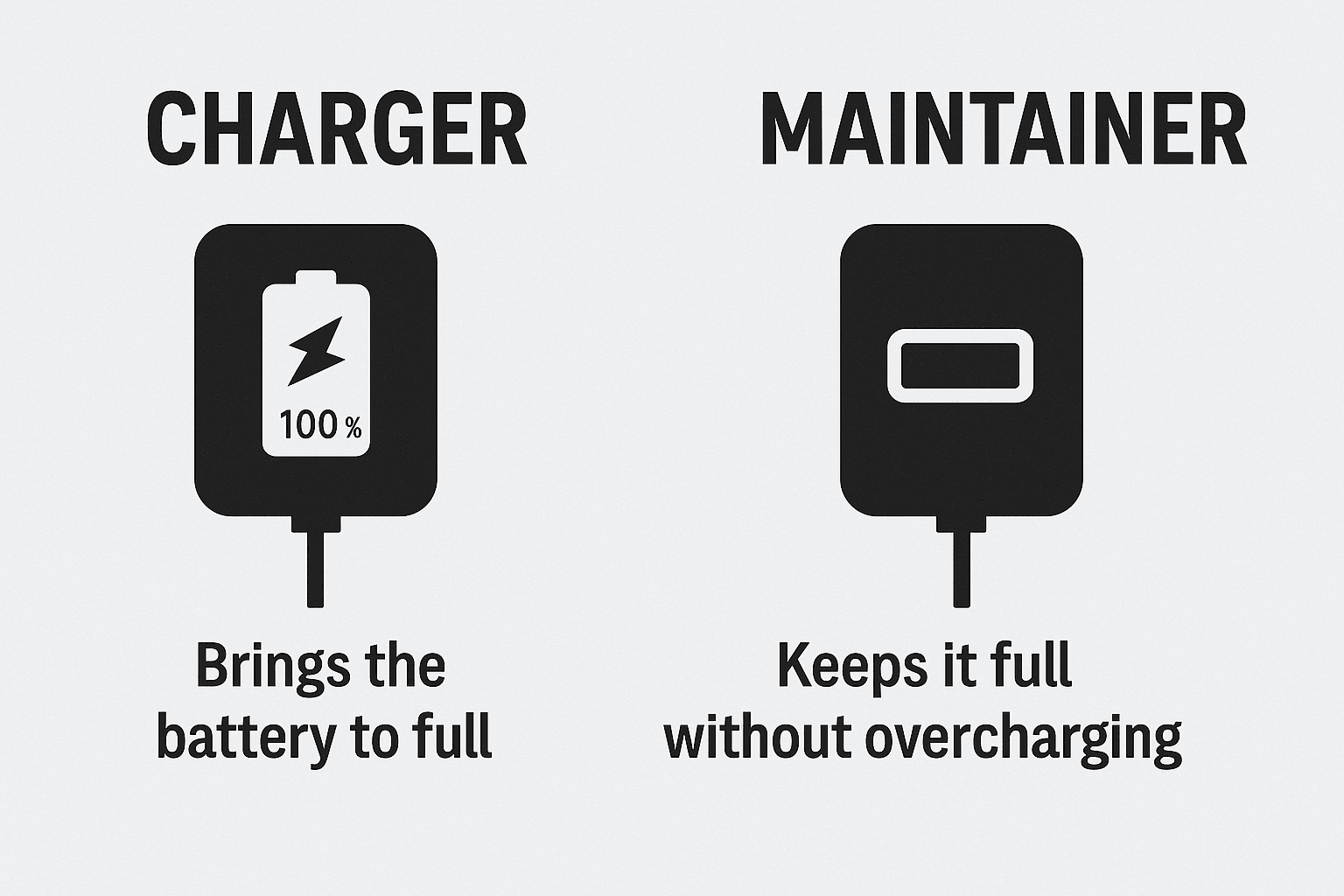
Can I use a car battery charger on my motorcycle?
Not a good idea. Most car chargers push too much current for motorcycle batteries. Unless it’s a smart charger with an adjustable amp output, you risk damaging your bike’s battery.
How often should I charge my motorcycle battery?
If you ride regularly, your charging system should handle it. But if your bike sits for more than a week or two, it’s smart to keep the battery on a maintainer.
Do I need a special charger for lithium batteries?
Yes. Lithium (LiFePO4) batteries require a different charging profile than lead-acid or AGM. Using the wrong charger can shorten lifespan or trigger battery protection circuits.
Can a charger fix a dead battery?
Sometimes. If the battery is just discharged, many smart chargers with recovery or Force Mode (like the NOCO GENIUS10) can bring it back. But if the battery is sulfated or damaged, no charger will save it.
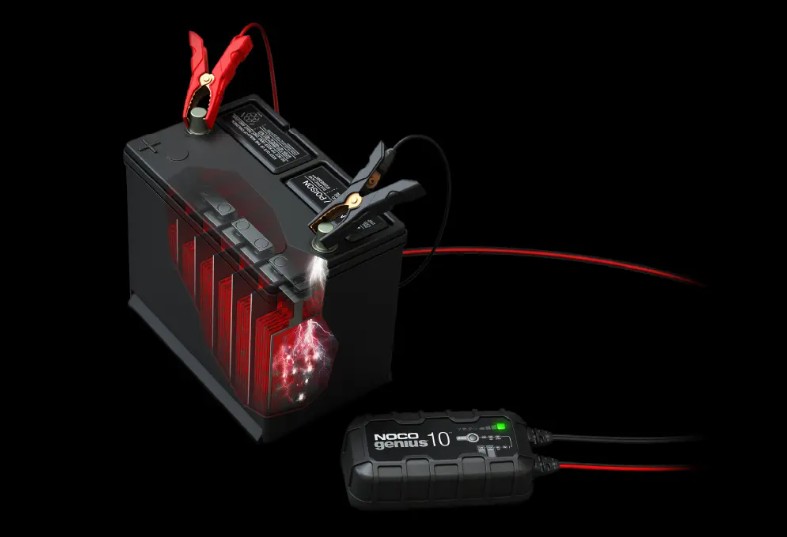
Source
Should I leave the charger connected all winter?
If it’s a smart charger, absolutely. That’s what it’s made for. Just plug it in and let it monitor your battery. If it’s a dumb trickle charger, disconnect it once the battery is full to avoid overcharging.
Wrapping up…
Using the right charger will keep your bike ready to fire up every time you twist the key. Whether you’re stashing the bike for winter, maintaining a lithium setup, or juggling multiple machines in the garage, there’s a charger in this lineup that fits your exact needs.

Source
Smart charging isn’t just a convenience anymore. It’s basic motorcycle maintenance. Chargers like the NOCO GENIUS10 or CTEK MXS 5.0 don’t just fill batteries, they protect them. And even the budget-friendly options like the Battery Tender Junior give you more peace of mind than a roll of jumper cables ever will.
So pick the charger that suits how you ride and how you store. Get it hooked up. Then forget about battery drama for good. That’s one less thing between you and the open road.
Related

Best Cruiser Tires for Motorcycle Riders in 2025
Discover the best cruiser tires of 2025 for riders—tested for grip, comfort, mileage, and style to keep your V-Twin planted and confident.


